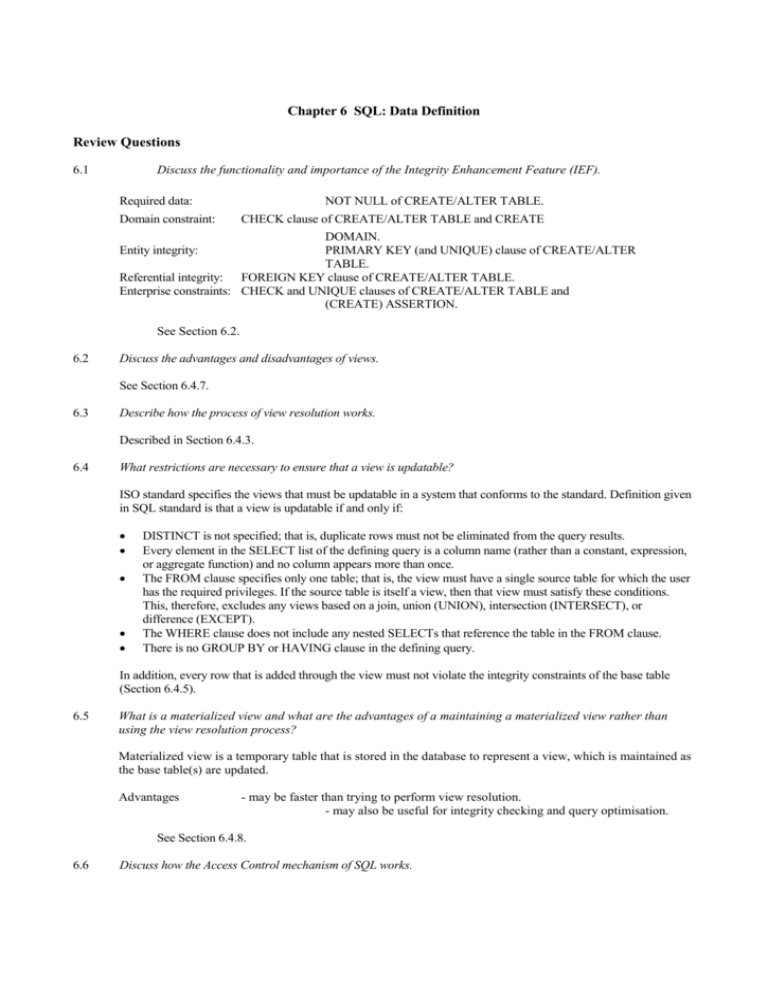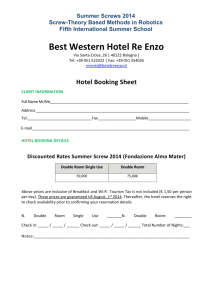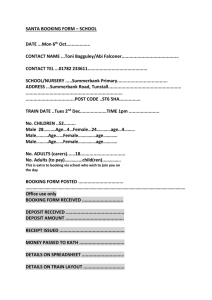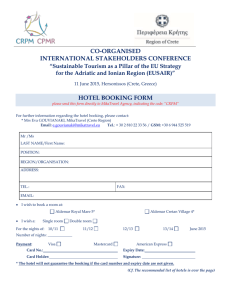Chapter 6 SQL: Data Definition
advertisement

Chapter 6 SQL: Data Definition Review Questions 6.1 Discuss the functionality and importance of the Integrity Enhancement Feature (IEF). Required data: Domain constraint: NOT NULL of CREATE/ALTER TABLE. CHECK clause of CREATE/ALTER TABLE and CREATE DOMAIN. PRIMARY KEY (and UNIQUE) clause of CREATE/ALTER TABLE. Referential integrity: FOREIGN KEY clause of CREATE/ALTER TABLE. Enterprise constraints: CHECK and UNIQUE clauses of CREATE/ALTER TABLE and (CREATE) ASSERTION. Entity integrity: See Section 6.2. 6.2 Discuss the advantages and disadvantages of views. See Section 6.4.7. 6.3 Describe how the process of view resolution works. Described in Section 6.4.3. 6.4 What restrictions are necessary to ensure that a view is updatable? ISO standard specifies the views that must be updatable in a system that conforms to the standard. Definition given in SQL standard is that a view is updatable if and only if: DISTINCT is not specified; that is, duplicate rows must not be eliminated from the query results. Every element in the SELECT list of the defining query is a column name (rather than a constant, expression, or aggregate function) and no column appears more than once. The FROM clause specifies only one table; that is, the view must have a single source table for which the user has the required privileges. If the source table is itself a view, then that view must satisfy these conditions. This, therefore, excludes any views based on a join, union (UNION), intersection (INTERSECT), or difference (EXCEPT). The WHERE clause does not include any nested SELECTs that reference the table in the FROM clause. There is no GROUP BY or HAVING clause in the defining query. In addition, every row that is added through the view must not violate the integrity constraints of the base table (Section 6.4.5). 6.5 What is a materialized view and what are the advantages of a maintaining a materialized view rather than using the view resolution process? Materialized view is a temporary table that is stored in the database to represent a view, which is maintained as the base table(s) are updated. Advantages - may be faster than trying to perform view resolution. - may also be useful for integrity checking and query optimisation. See Section 6.4.8. 6.6 Discuss how the Access Control mechanism of SQL works. Each user has an authorization identifier (allocated by DBA). Each object has an owner. Initially, only owner has access to an object but the owner can pass privileges to carry out certain actions on to other users via the GRANT statement and take away given privileges using REVOKE. Exercises Answer the following questions using the relational schema from the Exercises at the end of Chapter 3. 6.7 Create the Hotel table using the integrity enhancement features of SQL. CREATE DOMAIN HotelNumber AS CHAR(4); CREATE TABLE Hotel( hotelNo HotelNumber hotelName VARCHAR(20) city VARCHAR(50) PRIMARY KEY (hotelNo)); 6.8 NOT NULL, NOT NULL, NOT NULL, Now create the Room, Booking, and Guest tables using the integrity enhancement features of SQL with the following constraints: (a) (b) (c) (d) (e) (f) Type must be one of Single, Double, or Family. Price must be between £10 and £100. roomNo must be between 1 and 100. dateFrom and dateTo must be greater than today’s date. The same room cannot be double booked. The same guest cannot have overlapping bookings. CREATE DOMAIN RoomType AS CHAR(1) CHECK(VALUE IN (‘S’, ‘F’, ‘D’)); CREATE DOMAIN HotelNumbers AS HotelNumber CHECK(VALUE IN (SELECT hotelNo FROM Hotel)); CREATE DOMAIN RoomPrice AS DECIMAL(5, 2) CHECK(VALUE BETWEEN 10 AND 100); CREATE DOMAIN RoomNumber AS VARCHAR(4) CHECK(VALUE BETWEEN ‘1’ AND ‘100’); CREATE TABLE Room( roomNo RoomNumber NOT NULL, hotelNo HotelNumbers NOT NULL, type RoomType NOT NULL DEFAULT ‘S’ price RoomPrice NOT NULL, PRIMARY KEY (roomNo, hotelNo), FOREIGN KEY (hotelNo) REFERENCES Hotel ON DELETE CASCADE ON UPDATE CASCADE); CREATE DOMAIN GuestNumber AS CHAR(4); CREATE TABLE Guest( guestNo GuestNumber guestName VARCHAR(20) guestAddress VARCHAR(50) NOT NULL, NOT NULL, NOT NULL); CREATE DOMAIN GuestNumbers AS GuestNumber CHECK(VALUE IN (SELECT guestNo FROM Guest)); CREATE DOMAIN BookingDate AS DATETIME CHECK(VALUE > CURRENT_DATE); CREATE TABLE Booking( hotelNo HotelNumbers NOT NULL, guestNo GuestNumbers NOT NULL, dateFrom BookingDate NOT NULL, dateTo BookingDate NULL, roomNo RoomNumber NOT NULL, PRIMARY KEY (hotelNo, guestNo, dateFrom), FOREIGN KEY (hotelNo) REFERENCES Hotel ON DELETE CASCADE ON UPDATE CASCADE, FOREIGN KEY (guestNo) REFERENCES Guest ON DELETE NO ACTION ON UPDATE CASCADE, FOREIGN KEY (hotelNo, roomNo) REFERENCES Room ON DELETE NO ACTION ON UPDATE CASCADE, CONSTRAINT RoomBooked CHECK (NOT EXISTS ( SELECT * FROM Booking b WHERE b.dateTo > Booking.dateFrom AND b.dateFrom < Booking.dateTo AND b.roomNo = Booking.roomNo AND b.hotelNo = Booking.hotelNo)), CONSTRAINT GuestBooked CHECK (NOT EXISTS ( SELECT * FROM Booking b WHERE b.dateTo > Booking.dateFrom AND b.dateFrom < Booking.dateTo AND b.guestNo = Booking.guestNo))); 6.9 Create a separate table with the same structure as the Booking table to hold archive records. Using the INSERT statement, copy the records from the Booking table to the archive table relating to bookings before 1st January 20000. Delete all bookings before 1st January 2000 from the Booking table. CREATE TABLE BookingOld( hotelNo guestNo dateFrom dateTo roomNo CHAR(4) CHAR(4) DATETIME DATETIME VARCHAR(4) NOT NULL, NOT NULL, NOT NULL, NULL, NOT NULL); INSERT INTO BookingOld (SELECT * FROM Booking WHERE dateTo < DATE’2000-01-01’); DELETE FROM Booking WHERE dateTo < DATE’2000-01-01’; 6.10 Create a view containing the hotel name and the names of the guests staying at the hotel. CREATE VIEW HotelData(hotelName, guestName) AS SELECT h.hotelName, g.guestName FROM Hotel h, Guest g, Booking b WHERE h.hotelNo = b.hotelNo AND g.guestNo = b.guestNo AND b.dateFrom <= CURRENT_DATE AND b.dateTo >= CURRENT_DATE; 6.11 Create a view containing the account for each guest at the Grosvenor Hotel. CREATE VIEW BookingOutToday AS SELECT g.guestNo,g.guestName,g.guestAddress,r.price*(b.dateTo-b.dateFrom) FROM Guest g, Booking b, Hotel h, Room r WHERE g.guestNo = b.guestNo AND r.roomNo = b.roomNo AND b.hotelNo = h.hotelNo AND h.hotelName = ‘Grosvenor Hotel’ AND b.dateTo = CURRENT_DATE; 6.12 Give the users Manager and Deputy full access to these views, with the privilege to pass the access on to other users. GRANT ALL PRIVILEGES ON HotelData TO Manager, Director WITH GRANT OPTION; GRANT ALL PRIVILEGES ON BookingOutToday TO Manager, Director WITH GRANT OPTION; 6.13 Give the user Accounts SELECT access to these views. Now revoke the access from this user. GRANT SELECT ON HotelData TO Accounts; GRANT SELECT ON BookingOutToday TO Accounts; REVOKE SELECT ON HotelData FROM Accounts; REVOKE SELECT ON BookingOutToday FROM Accounts; Consider the following view defined on the Hotel schema: 6.14 CREATE VIEW HotelBookingCount (hotelNo, bookingCount) AS SELECT h.hotelNo, COUNT(*) FROM Hotel h, Room r, Booking b WHERE h.hotelNo = r.hotelNo AND r.roomNo b.roomNo GROUP BY h.hotelNo; For each of the following queries, state whether the query is valid and for the valid ones should how each of the queries would be mapped onto a query on the underling base tables. (a) SELECT * FROM HotelBookingCount; SELECT h.hotelNo, COUNT(*) FROM Hotel h, Room r, Booking b WHERE h.hotelNo = r.hotelNo AND r.roomNo b.roomNo GROUP BY h.hotelNo; (b) SELECT hotelNo FROM HotelBookingCount WHERE hotelNo = ‘H001’; SELECT h.hotelNo FROM Hotel h, Room r, Booking b WHERE h.hotelNo = r.hotelNo AND r.roomNo b.roomNo AND h.hotelNo = ‘H001’ GROUP BY h.hotelNo; (c) SELECT MIN(bookingCount) FROM HotelBookingCount; Invalid – bookingCount is based on an aggregate function, so cannot be used within another aggregate function. (d) SELECT COUNT(*) FROM HotelBookingCount; Invalid for reason given above. (e) SELECT hotelNo FROM HotelBookingCount WHERE bookingCount > 1000; Invalid – bookingCount is based on an aggregate function, so cannot be used in the WHERE clause. (f) SELECT hotelNo FROM HotelBookingCount ORDER BY bookingCount; SELECT h.hotelNo, COUNT(*) AS bookingCount FROM Hotel h, Room r, Booking b WHERE h.hotelNo = r.hotelNo AND r.roomNo b.roomNo GROUP BY h.hotelNo ORDER BY bookingCount; General 6.15 Consider the following table: Part (partNo, contract, partCost) which represents the cost negotiated under each contract for a part (a part may have a different price under each contract). Now consider the following view ExpensiveParts, which contains the distinct part numbers for parts that cost more than £1000: CREATE VIEW ExpensiveParts (partNo) AS SELECT DISTINCT partNo FROM Part WHERE partCost > 1000; Discuss how you would maintain this as a materialized view and under what circumstances you would be able to maintain the view without having to access the underlying base table Part. If a row is inserted into Part with a partCost less than or equal to £1000, the view would not have to be updated. If a partNo is inserted into Part that is already in the view, no new record has to be inserted into the view (because of the DISTINCT keyword). Similarly for update. If a partNo is deleted from Part have to access the underlying base table to check if there is another partNo with same value, to determine whether row should be deleted from the view. 6.16 Assume that we also have a table for suppliers: Supplier (supplierNo, partNo, price) and a view SupplierParts, which contains the distinct part numbers that are supplied by at least one supplier: CREATE VIEW SupplierParts (partNo) AS SELECT DISTINCT partNo FROM Supplier s, Part p WHERE s.partNo = p.partNo; Discuss how you would maintain this as a materialized view and under what circumstances you would be able to maintain the view without having to access the underlying base tables Part and Supplier. 6.17 Investigate the SQL dialect on any DBMS that you are currently using. Determine the system’s compliance with the DDL statements in the ISO standard. Investigate the functionality of any extensions the DBMS supports. Are there any functions not supported? This is a small student project, the result of which is dependent on the dialect of SQL being used. 6.18 Create the DreamHome rental database schema defined in Section 3.2.6 and insert the tuples shown in Figure 3.3. This is a small student project, the result of which is dependent on the DBMS being used. 6.19 Using the schema you have created above, run the SQL queries given in the examples from Chapter 5. This is a small student project, the result of which is dependent on the DBMS being used. 6.20 Create the schema for the Hotel schema given at the start of the exercises for Chapter 3 and insert some sample tuples. Now run the SQL queries that you produced for Exercises 5.7 – 5.28. This is a small student project, the result of which is dependent on the DBMS being used.





